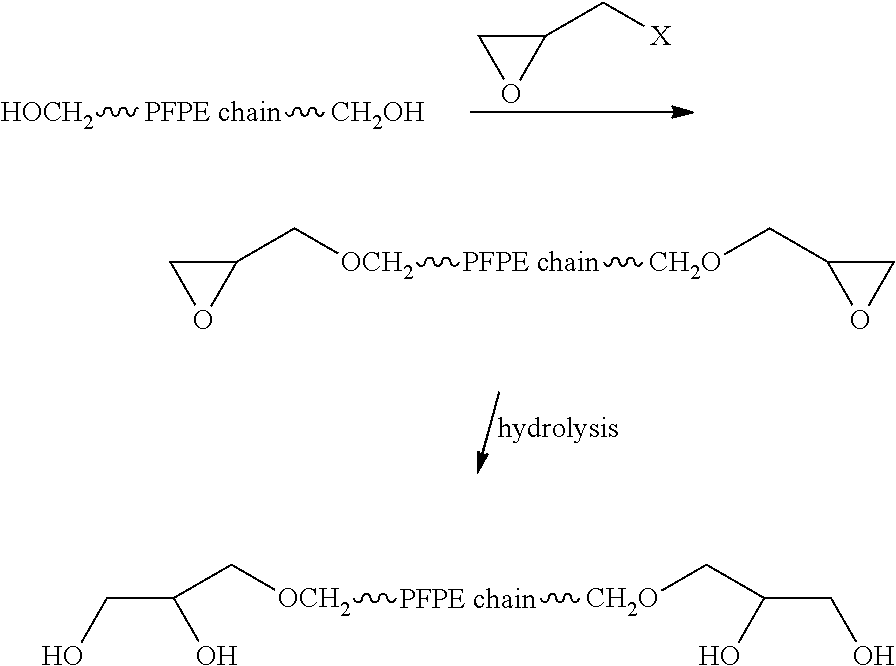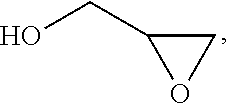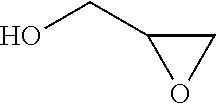Process for the purification of polyol PFPE derivatives
- Summary
- Abstract
- Description
- Claims
- Application Information
AI Technical Summary
Benefits of technology
Problems solved by technology
Method used
Image
Examples
example 2
Synthesis of Mixture (M2)
Reaction of FOMBLIN® Z-DOL 2000 PFPE (Polydispersity Index 1.25) with Glycidol
[0113]Same procedure as detailed in Example 1, synthesis of mixture (M1), was followed, but reacting 3.58 eq. of FOMBLIN® Z-DOL 2000 PFPE (EW 1006 g / eq.; polydispersity index 1.25) with 4.83 moles of glycidol during 5 hours.
[0114]The reaction product (3.38 eq.) was recovered by distillation under reduced pressure (yield: 94.5%) and characterized by 1H-NMR analysis following same procedure as detailed in Example 1.
[0115]The analysis yielded the following end-groups composition:[0116]5% by moles of end-groups of formula —CF2CH2OH;[0117]68% by moles of end-groups of formula —CF2CH2OCH2CH(OH)CH2OH;[0118]27% by moles of end-groups of formula —CF2CH2OCH2CH(OH)CH2OCH2CH(OH)CH2OH.
[0119]As determined by GPC analysis, the product had an average molecular weight of 2196 g / mol and a polydispersity index of 1.28.
Step 2.1: Protection of Vicinal Hydroxyl Groups
[0120]Same procedure as detailed in ...
example 3
Synthesis of Mixture (M3)
Reaction of FOMBLIN® Z-DOL 1000 PFPE (Polydispersity Index 1.07) with Glycidol
[0133]Same procedure as detailed in Example 1, synthesis of mixture (M1), was followed, but reacting into a 5 lt. reactor 2.0 eq. of FOMBLIN® Z-DOL 1000 PFPE (EW 501 g / eq.; polydispersity index 1.07), 0.20 moles of potassium tert-butylate and 2.7 moles of glycidol during 5 hours and recovering a crude product by washing with a mixture of 350 g of demineralised water, 100 g of a 30 wt. % aqueous solution of HCl and 350 g of isobutylic alcohol and subsequent washing with 2×240 g of demineralised water. The reaction product (1.89 eq.) was recovered by distillation under reduced pressure (yield: 94.1%) and characterized by 1H-NMR analysis following same procedure as detailed in Example 1, synthesis of mixture (M1).
[0134]The analysis yielded the following end-groups composition:[0135]3% by moles of end-groups of formula —CF2CH2OH;[0136]71% by moles of end-groups of formula —CF2CH2OCH2CH...
example 4
Synthesis of Mixture (M4)
Reaction of FOMBLIN® Z-DOL 3000 PFPE (Polydispersity Index 1.08) with Glycidol
[0152]Same procedure as detailed in Example 1, synthesis of mixture (M1), was followed, but reacting 3.5 eq. of FOMBLIN® Z-DOL 3000 PFPE (EW 1520 g / eq.; polydispersity index 1.08) with 4.73 moles of glycidol during 5 hours. The reaction product (3.43 eq.) was recovered by distillation under reduced pressure (yield: 98%) and characterized by 1H-NMR analysis following same procedure as detailed in Example 1, synthesis of mixture (M1).
[0153]The analysis yielded the following end-groups composition:[0154]6% by moles of end-groups of formula —CF2CH2OH;[0155]71% by moles of end-groups of formula —CF2CH2OCH2CH(OH)CH2OH;[0156]23% by moles of end-groups of formula —CF2CH2OCH2CH(OH)CH2OCH2CH(OH)CH2OH.
[0157]As determined by GPC analysis, the product had an average molecular weight of 3151 g / mol and a polydispersity index of 1.10.
Step 4.1: Protection of Vicinal Hydroxyl Groups
[0158]Same proced...
PUM
| Property | Measurement | Unit |
|---|---|---|
| Length | aaaaa | aaaaa |
| Ratio | aaaaa | aaaaa |
| Polydispersity index | aaaaa | aaaaa |
Abstract
Description
Claims
Application Information
 Login to View More
Login to View More - R&D
- Intellectual Property
- Life Sciences
- Materials
- Tech Scout
- Unparalleled Data Quality
- Higher Quality Content
- 60% Fewer Hallucinations
Browse by: Latest US Patents, China's latest patents, Technical Efficacy Thesaurus, Application Domain, Technology Topic, Popular Technical Reports.
© 2025 PatSnap. All rights reserved.Legal|Privacy policy|Modern Slavery Act Transparency Statement|Sitemap|About US| Contact US: help@patsnap.com



